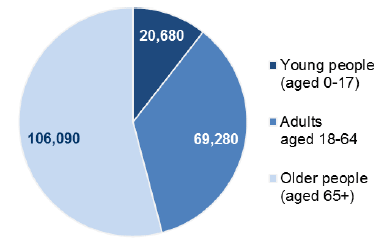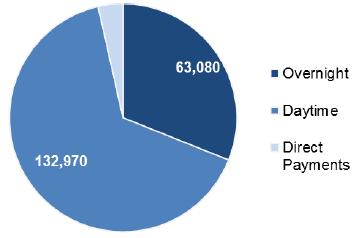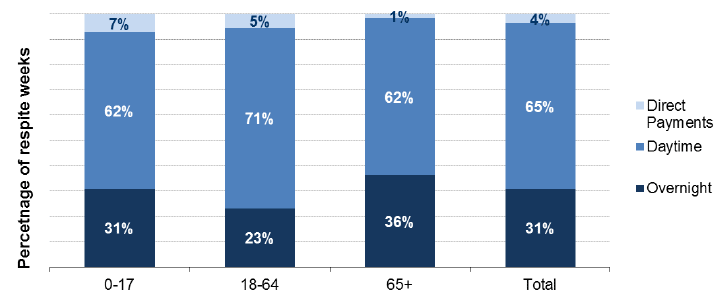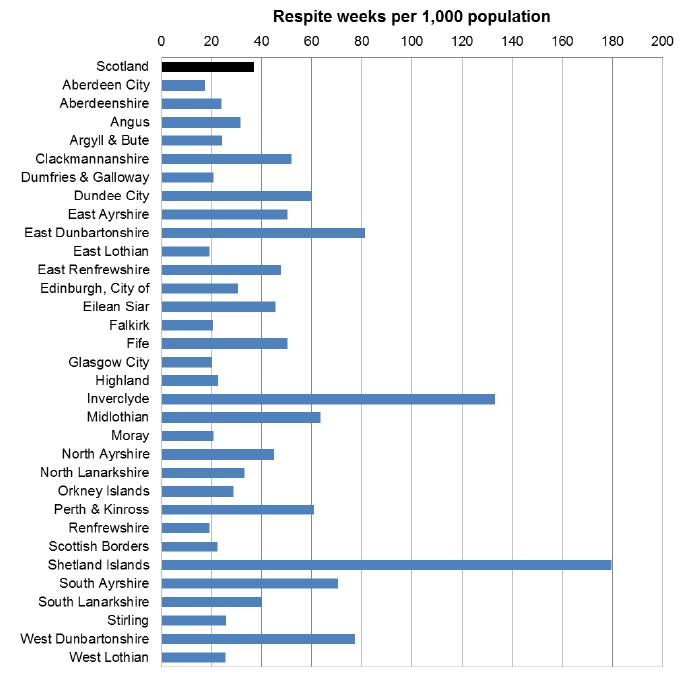Respite Care Scotland, 2015
Presents information on respite care services provided or purchased by Local Authorities in Scotland. Respite Care is a service intended to benefit a carer and the person he or she cares for by providing a short break from caring tasks.
This document is part of a collection
2. Summary of 2014/15 respite provision
There are many different types of respite care. For example, the cared-for person has a break away from home for a few nights, giving the carer time to do something that they would not otherwise be able to. Alternatively, services can be put in place to support the cared-for person to allow the carer to have a break away from home. Some people want to have a break together, with additional support to make this happen. Sometimes the service is provided in the home for the cared-for person, with the carer having time to do something themselves for a couple of hours during the day. This Release looks separately at overnight respite stays and daytime respite care. Respite nights and hours are converted to respite weeks using the rates of 7 nights per week and 52.5 hours per week.
Some people also choose to receive a cash payment (called a Direct Payment) to buy the care services that they need. In order to provide as complete as possible a picture of respite care provision in 2014/15, this section of the Release combines information on overnight and daytime weeks with a preliminary estimate of the number of additional weeks of respite care that have been provided through Direct Payments. This latter estimate has been made by collecting information on the financial values of Direct Payments provided by Local Authorities for the purpose of providing respite care. These financial values are then converted to an estimated number of respite weeks using the rate of £630 per week / £12 per hour derived from estimates of residential care weekly costs made by the Respite Task Group[7].
Only 21 out of 32 Local Authorities were able to submit 2014/15 Direct Payments information, so the estimated total number of respite weeks provided in this way will be less than the true value across Scotland. Two of the Authorities that did submit Direct Payments information (East Dunbartonshire and Fife) are known to have included the respite care provided through these payments in their overnight / daytime respite data. To avoid double-counting of such care, the financial value derived estimates for these Authorities have been excluded from the respite week totals presented in this section. Further analysis of the financial values of Direct Payments made is contained in Section 5 of this Release.
In addition to the 196,060 overnight and daytime respite weeks provided in Scotland in 2014/15, there were at least a further 7,160 weeks provided through Direct Payments.
Chart 2: Number of respite weeks by cared-for age group, excluding Direct Payments, 2014/15

Chart 3: Number of respite weeks by type of care, including Direct Payments, 2014/15

Source: Scottish Government 2014/15
Note: Only 21 out of 32 Local Authorities were able to submit Direct Payment data. Two of these have been excluded from the Direct Payments figures above to prevent double-counting of respite weeks. These factors mean that the 7,160 respite weeks provided through Direct Payments in Chart 3 will be an underestimate of the true value.
Chart 2 shows that the carers of older people (aged 65 and over) benefitted from 106,090 (54%) of the combined respite weeks provided in Scotland in 2014/15, those of adults aged 18-64 from 69,280 weeks (35%) and those providing care for young people (aged 0-17) from 20,680 weeks (11%). Including the additional weeks provided through Direct Payments alters this slightly, to 53% for carers of older people, 36% for adults aged 18-64 and 11% for young people.
Daytime respite care accounted for almost two-thirds of the combined respite weeks provided in Scotland in 2014/15, more than twice as many as overnight care, as shown in Chart 3. Direct Payments were used to provide 7,160 weeks (6%) of respite care. However, it must be remembered that the number of respite weeks provided through Direct Payments is likely to be an underestimate.
Chart 4: Proportion of respite weeks by cared-for age group and type of care, including Direct Payments, 2014/15

Source: Scottish Government 2014/15
Note: Only 21 out of 32 Local Authorities were able to submit Direct Payment data. Two of these have been excluded from the Direct Payments figures above to prevent double-counting of respite weeks. These factors mean that the Direct Payments figures in Chart 4 will be an underestimate of the true value.
Chart 4 shows that a higher proportion of carers of adults aged 18-64 receive respite during daytime compared to the other age groups. Carers of older people receive more respite overnight than the other groups, but less respite through Direct Payments.
Chart 5: Overnight and daytime respite weeks provided in 2014/15, expressed as a rate per 1,000 population, by Local Authority

Source: Scottish Government 2014/15
Population figures: National Records of Scotland mid-year population estimates
The per-capita rates of recorded overnight and daytime respite week provision in 2014/15 for each Local Authority in Scotland are given in Chart 5. Any additional weeks of care provided through Direct Payments are excluded from this analysis, on the basis that not all Authorities were able to submit this information. This means, however, that the rates for Local Authorities that provide respite care through Direct Payments is likely to be understated in Chart 5.
The differing rates of recorded respite provision between Local Authorities are thought to be due to variations in the types of respite care they are counting and the methodology they use to calculate hours and nights of care. More information on this is provided in Section 5.6.
Contact
Email: Steven Gillespie
There is a problem
Thanks for your feedback